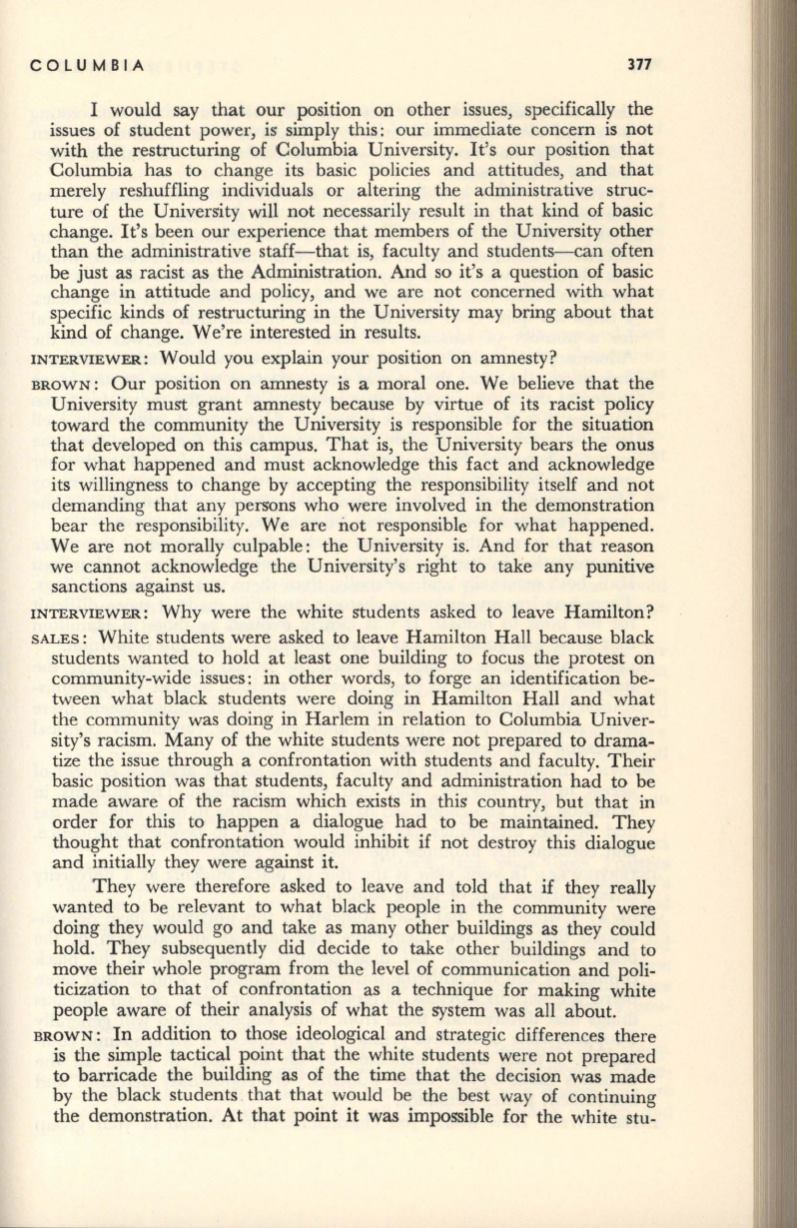
COLUMBIA
377
I would say that our posItIon on other issues, specifically the
issues of student power, is simply this: our immediate concern is not
with the restructuring of Columbia University. It's our position that
Columbia has to change its basic policies and attitudes, and that
merely reshuffling individuals or altering the administrative struc–
ture of the University will not necessarily result in that kind of basic
change. It's been our experience that members of the University other
than the administrative staff-that is, faculty and students-can often
be just as racist as the Administration. And so it's a question of basic
change in attitude and policy, and we are not concerned with what
specific kinds of restructuring in the University may bring about that
kind of change. We're interested in results.
INTERVIEWER:
Would you explain your position on amnesty?
BROWN:
Our position on amnesty is a moral one. We believe that the
University must grant amnesty because by virtue of its racist policy
toward the community the University is responsible for the situation
that developed on this campus. That is, the University bears the onus
for what happened and must acknowledge this fact and acknowledge
its willingness to change by accepting the responsibility itself and not
demanding that any persons who were involved in the demonstration
bear the responsibility. We are not responsible for what happened.
We are not morally culpable: the University is. And for that reason
we cannot acknowledge the University's right to take any punitive
sanctions against us.
INTERVIEWER:
Why were the white students asked to leave Hamilton?
SALES:
White students were asked to leave Hamilton Hall because black
students wanted to hold at least one building to focus the protest on
community-wide issues: in other words, to forge an identification be–
tween what black students were doing in Hamilton Hall and what
the community was doing in Harlem in relation to Columbia Univer–
sity's racism. Many of the white students were not prepared to drama–
tize the issue through a confrontation with students and faculty. Their
basic position was that students, faculty and administration had to be
made aware of the racism which exists in this country, but that in
order for this to happen a dialogue had to be maintained. They
thought that confrontation would inhibit if not destroy this dialogue
and initially they were against it.
They were therefore asked to leave and told that if they really
wanted to be relevant to what black people in the community were
doing they would go and take as many other buildings as they could
hold. They subsequently did decide to take other buildings and to
move their whole program from the level of communication and poli–
ticization to that of confrontation as a technique for making white
people aware of their analysis of what the system was all about.
BROWN:
In addition to those ideological and strategic differences there
is the simple tactical point that the white students were not prepared
to barricade the building as of the time that the decision was made
by the black students . that that would be the best way of continuing
the demonstration. At that point it was impossible for the white stu-


